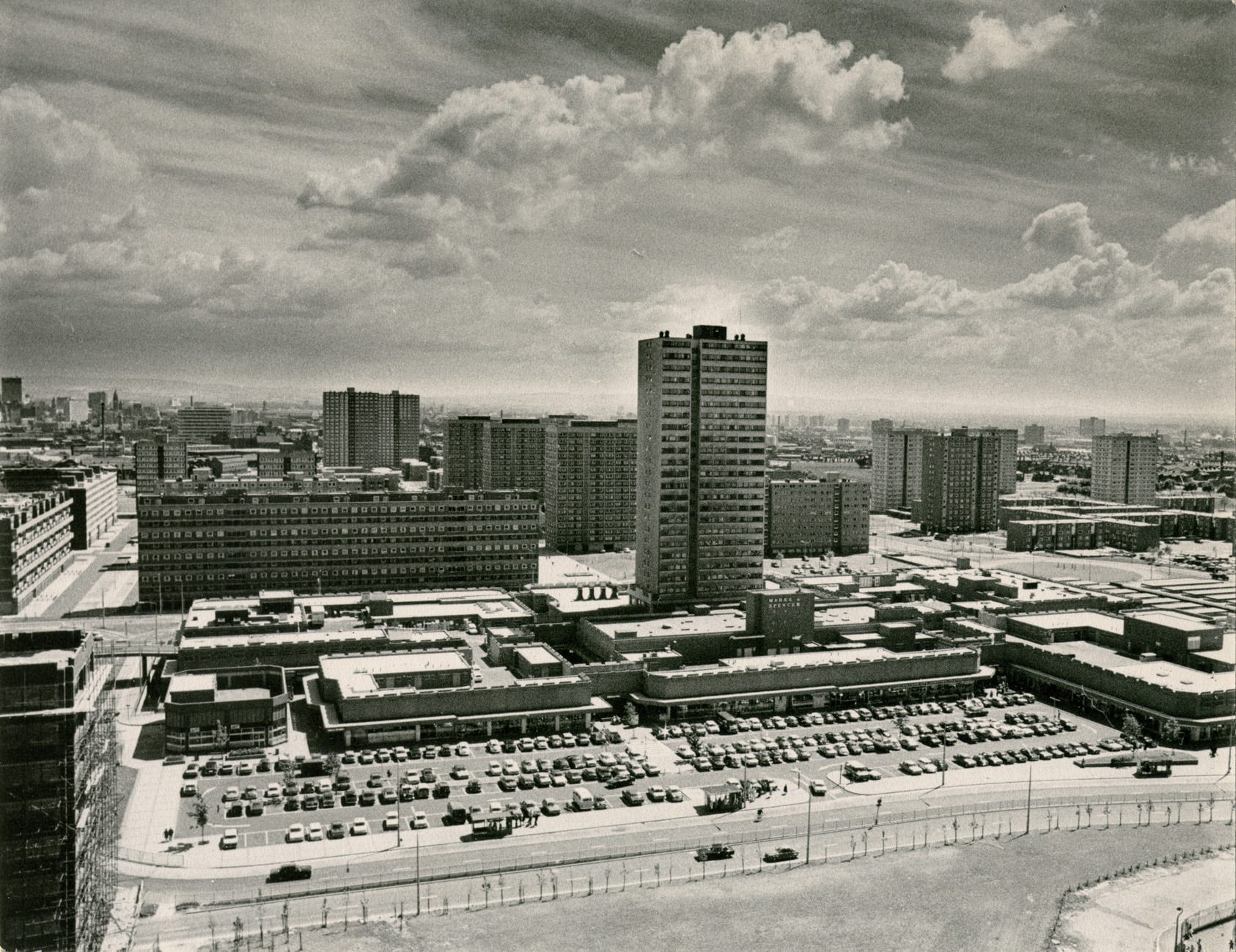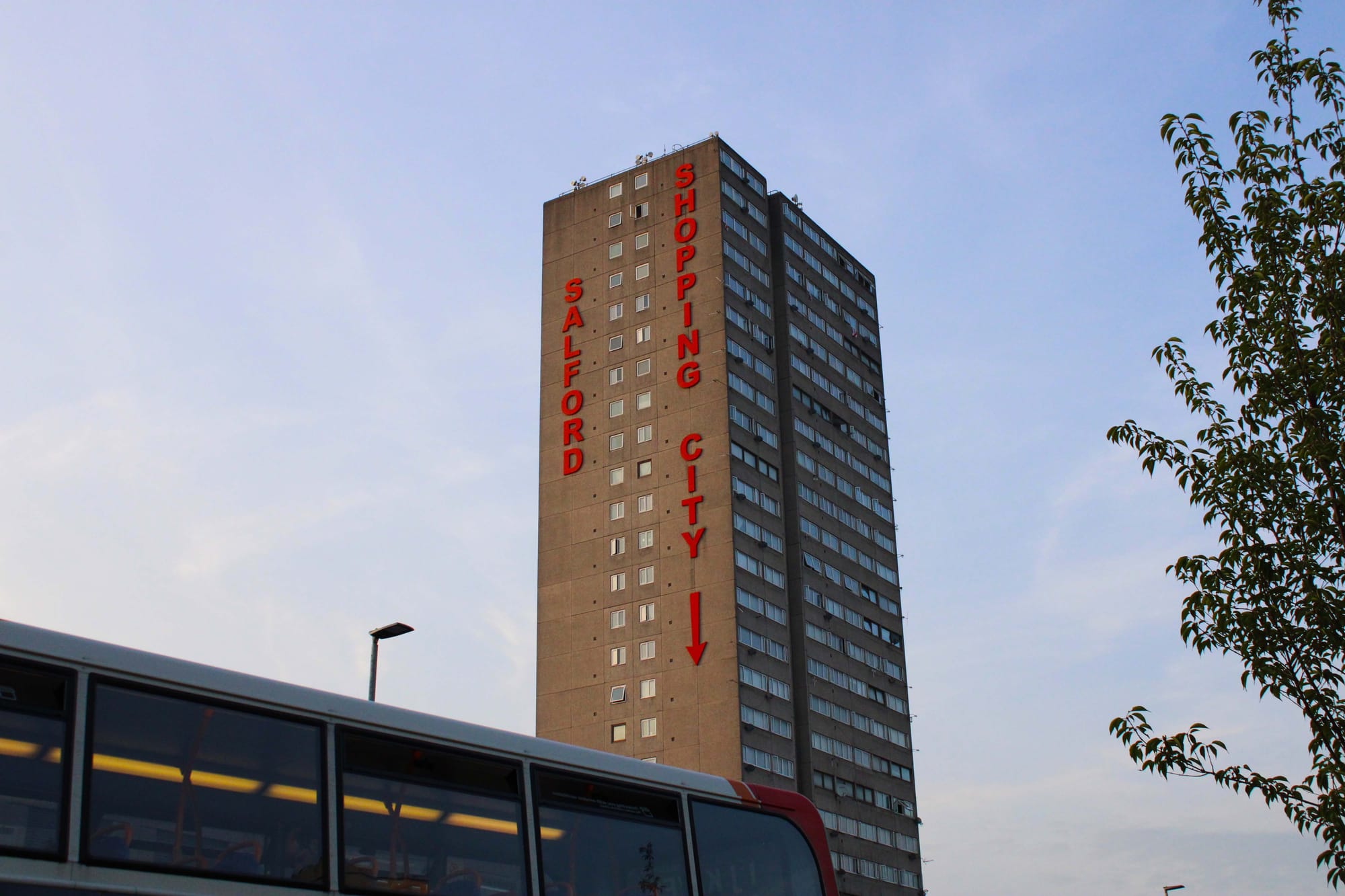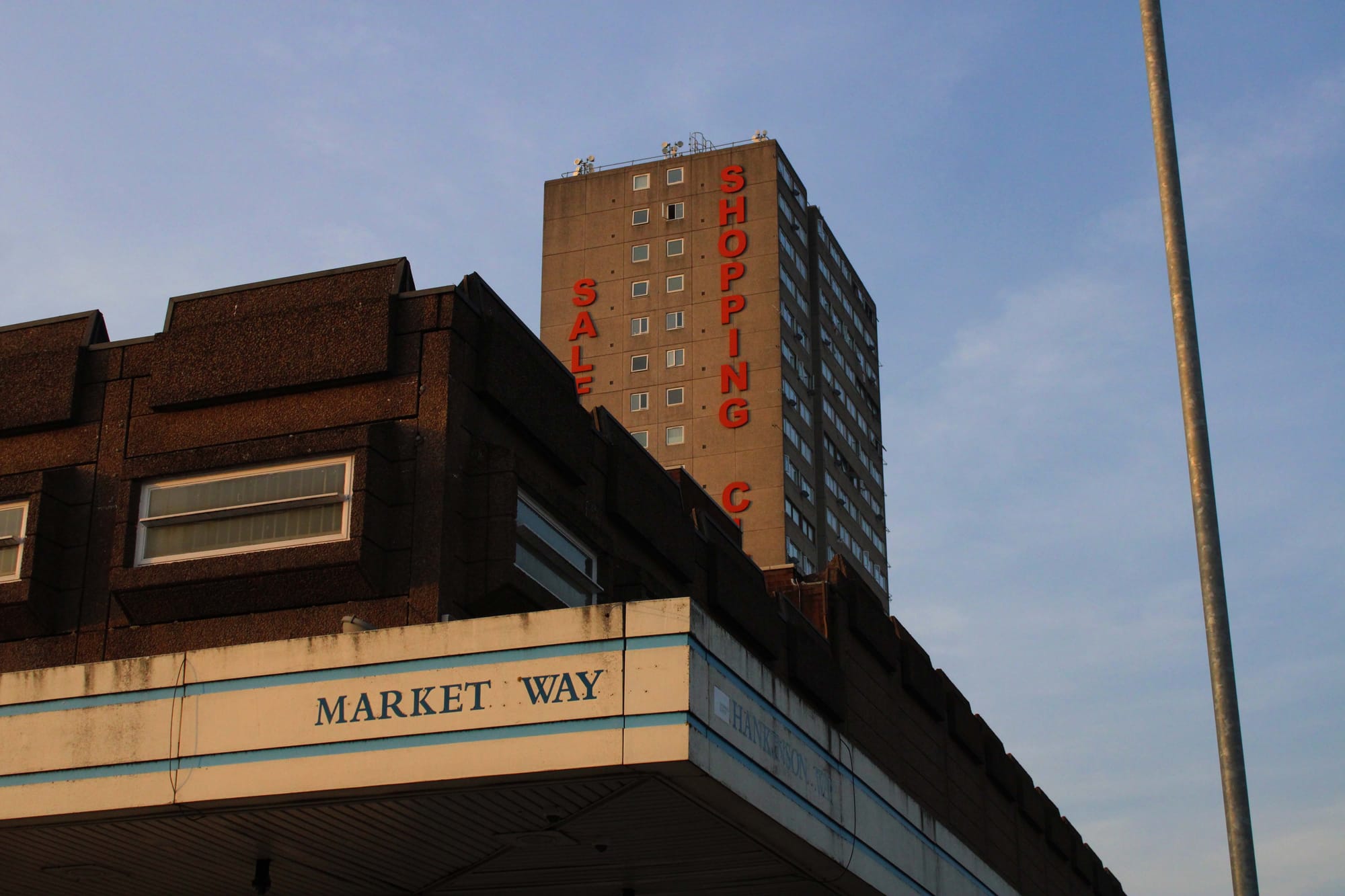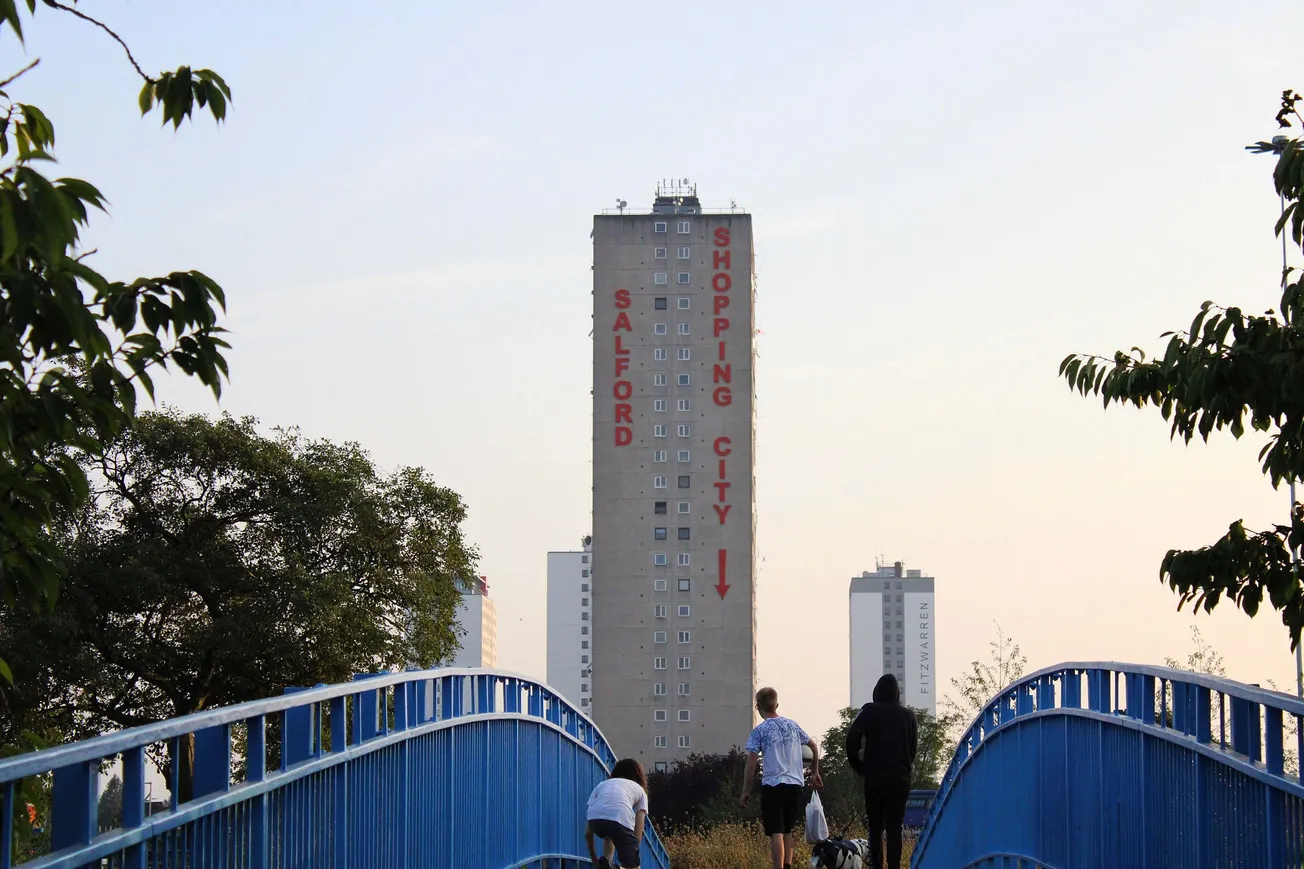By Jack Dulhanty
It’s a Wednesday lunchtime in Salford Shopping Centre. A girl has her eyebrows threaded while her little brother sits on his phone and waits. A mother pushing a pram tells the child walking beside her that she’d never tell her off for slapping someone who slapped her first. The child nods while looking straight ahead.
Staff chat in the middle of the walkways, leaning on mops and buckets. The centre is near enough empty. Silent except for the metallic crunch of a heavy security door closing, as tenants pass in and out of Briar Hill Court — the 250ft tower block driven through the middle of the centre like a stake, its entrance slotted in between two retail units.
Briar Hill Court is one of the oldest residential blocks still standing in Salford. Built in 1970, it marked the end of a slum clearance programme that started in Pendleton in the early 1950s. Some 6,000 terraced houses were demolished across a 300-acre site to make way for the redevelopment, which included the two-storey brutalist shopping centre and the 25-storey tower block.
Today, the whole complex is the object of ridicule and disdain, a highly visible emblem of urban failure and neglect. Everyone in Salford knows it from the red lettering that tumbles down two of its sides. SALFORD SHOPPING CITY, it booms, with an arrow pointing down.
After he was elected in 2016, Salford’s mayor Paul Dennett described the tower as an eyesore. Councillor John Warmisham branded it “an absolute disgrace.” But going past it every day on my way to work, I started to wonder: Who lives in Briar Hill Court? And what is life like in Salford’s most detested tower block?

Kelly Gregson approaches the security door, pushing a shopping trolley that doubles as a walker. She hasn’t got her fob for the security door, only her flat key — “shit!” She’s just been shopping, and this happens to her all the time. She speaks with the rhythm of a pair of castanets for a few more moments and then: “Anyway, you were going to ask me something? I’m Canadian, not American, by the way.”
I explain that I’m a journalist looking to talk to tenants from the block and that pressing 22 on the keypad beside the door will put you through to the manager’s office, where they will open the security door. “Oh my god, 22, I need to remember that, thank you so much,” she says.
Inside, the block is plainly furnished, all the walls are white, the steps a solid red, and the lights glow butter-yellow. A tiny security office, 2-by-2 metres at most, is empty except for a dartboard on the wall. Initially, there is no answer at the manager’s office. A delivery man in a blue and gold dashiki forces a package through the letterbox of the neighbouring flat.
Then the office door opens and there is no manager — they’re based in Bury. There’s just Peter, the building’s caretaker for the last 17 years. Tenants I speak to unanimously agree Peter is “spot-on”, but he can’t agree to an interview without management approval.
Briar Hill Court is owned by Praxis Holdings (“one of the UK commercial property markets’ most active, reliable and discreet investors,” — as they call themselves) and is managed by Sterling Properties. The latter “specialise in the housing benefit market,” according to their website. The average rent here, depending on which tenant you speak to, is around £550pcm, meaning Salford’s Local Housing Allowance (LHA) of £138.08 a week covers it almost exactly. Sterling did not end up giving Peter permission to speak to me, and when we invited the company to comment for this story, they declined to do so.

The lift — I’m told tenants call it ‘the coffin’ — is four walls of cold treadplate steel, which tremble as it passes between floors and sometimes make a faint and oily splashing sound. As I step out I hear my feet unstick from the floor.
Each storey in Briar Hill shares an identical layout: two sets of three flats connected by a landing. There’s an overriding smell of dust and cigarette smoke, sometimes weed. Some floors have thicker, fuller smells, like old fruit. Others have been lined with indoor air fresheners by tenants hoping to cover whatever smell their floor has been assigned.
One man, named Alan, who is visiting a friend in the block, tells me: “Everybody just does what they want here." His friend’s landing was painted entirely purple by a neighbour. "The landlords are okay — they don't care,” he says. He says it took 7 months for his friend to get a broken window fixed: 6 months before having it looked at, one month to fix.
One tenant named Ray tells me, from behind a door covered in Manchester United stickers, that he’s looking to move out of the block: "The rent's £558 a month, and I don't think it's worth it,” he says. Like almost everyone I speak to, he is on housing benefit, and like most of the others, he says management is slow and ineffectual: "They don't like doing the work, you've got to keep mithering them, keep ringing. And, when they repair the problem, it just goes again."
There are 138,941 people in Greater Manchester who claim housing benefit, according to government statistics last updated in May, 16,157 of whom live in Salford. LHA was introduced in 2007 as a new way to calculate housing benefit entitlement. Originally, an area’s allowance represented the 50th percentile, the median, of rents in that area. This was cut to the 30th percentile in 2011, meaning LHA claimants could only access, say, the cheapest three properties out of ten in a given area.
In Salford, LHA is £138.08 a week for a one-bedroom apartment like the ones at Briar Hill. The percentile cut significantly narrowed options for claimants and means they are often casting around in the lower reaches of the private rental market.

“The place was so disgusting I had it professionally cleaned," says Kelly. "When I moved in here, they told me they'd clean the place up. They didn't.” Kelly’s flat is decorated with various references to George Orwell — 1984 specifically. Our interview is punctuated by mini-lectures on the parallels between the novel and modern life. Her handbag has a badge attached which reads: ‘Big Brother is watching you.’ She says the ‘Plandemic’ (a popular term among people who believe in a conspiracy theory that Covid-19 was a planned event) forced her to take the flat at Briar Hill.
It’s worth noting that not all tenants had complaints. One couple said they’ve had few problems, just one leak that was fixed quickly. Another man, who said he has been a tenant for 20 years, simply said “it’s just a block of flats.” His neighbour said she had multiple physical illnesses and the unreliability of lifts, which often break, make it difficult for her to get around the block.
The council owned Briar Hill Court until 2000 before selling it off to raise funds. Then it was hot-potatoed between private owners, who saw little use in investing in the building — the last major renovation was in 1995. By all accounts, living standards stagnated, then declined, with tenants — many desperate for somewhere, anywhere, to live — bearing the burden.
When standing on one of the higher floors at Briar Hill, where some of the floor numbers are written on the wall in pen, you can look out of a stairwell window and see the glimmering edifice of Anaconda Cut, the residential skyscraper that became the tallest building in the borough when it was topped out a few years ago. It has a yoga studio, a concierge service and a sky lounge on the 43rd floor. Residents here and residents there are experiencing very different versions of Salford’s 21st century signature: high-rise city centre living.

David moves delicately around his flat. He pulls the door with care and the latch just about clicks. He settles himself slowly into an armchair in front of a low coffee table scattered with some newspapers, an empty mug, and a set of keys. He moves as if he’s trying to maintain some sort of balance I can’t see. "I was on the streets for two years,” he says.
He narrates his life story in a clipped Wigan accent: a partner involved in drugs, leaving the home he’d shared with them for 10 years, coming to Manchester, descending into alcoholism, and becoming homeless. He wound up in Val’s Hotel, the now infamous guesthouse in Ardwick, where he was found by police on a bedbug-infested mattress. The floor he lived on shared one toilet that was seat-level with faeces. He lifts his forearms from the arms of his chair to show me the little silvery ponds of scar tissue scattered about them, from the bites he got living at Val’s.
David was removed from Val’s and taken to Nacro, a housing association: "Next thing I know, I get a phone call from Nacro housing, telling me they've got a place for me,” he says. "I go: 'Shut up, you're winding me up.' It was on April Fool’s Day. I packed my stuff up and thought: 'I'll still be here tomorrow.'" He lived in Nacro housing until February of this year, when he moved into Briar Hill, the first place he can call his own in over five years.
I ask him about some of the problems I’ve heard from other tenants: lack of investment, archaic flats, the state of the lifts. "Between the streets and here, here is better,” he says. “I've got a roof over my head, I can do my own cooking, I've got my own front door. Some people just take things for granted.” Although he echoes the concerns about the building’s lack of effective security. The six times I visit the block, I’m buzzed in without being asked who I am or whether I’m a tenant. I only see security once, and they watch me walk right by.
David tells me about an incident one night, at around 11pm: "A woman came knocking on my door. Not a hard knock, a sort of small knock. Then, I heard her knock next door. I opened my door, put the key lock on and said: 'can I help?' And she said: ‘d'you have a light?' So, I said yeah. I left the door open while I went to get the lighter, next thing she's in my hallway."
"Can I just stay for a couple of hours? I'm on the streets,'' David says, half-feigning a woman’s voice. “So, I said ‘I've got a baby asleep’, which I hadn't, and said ‘you're going to hav'go’. Next thing you know she was sleeping on the steps outside. After that, I've seen the caretaker checking around the building, and I think that must've happened a couple of times."

During my visits to Briar Hill, I pick up a general sense of suspicion and unease. This is a place where a lot of people have lived difficult lives. All the tenants I interview are initially reluctant to talk. Most won’t give their name, or their full name. One lies, and says they’re visiting friends in the block, then later admits they in fact do live here — they just wanted to suss me out first. When I asked one tenant the name of their cat, they wouldn’t tell me because “the landlords know I have a cat.” No one agrees to be photographed.
When I ask Sterling about the claims made by residents, they tell me I was trespassing on private property (I was buzzed into the building by the manager’s office on all of my visits). The company has not responded to our requests for comment.
One evening, I stop by the block after the shopping centre has closed. By that time, tenants have to go through two magnetised security doors to enter the building. I want to see if it’s as easy to enter the building after hours as it is in the day, to corroborate claims made by tenants of people from outside getting to their flats.
I dial 22 on the keypad to call the manager’s office, it rings, and then I hear the muted wheeze of the magnets releasing their grip. The door opens. I close it and go home.
This story is the fourth part of our Northern Project series, in which we are trying to focus more reporting on the north of Greater Manchester. If you have an idea to contribute to the series, please hit reply to this newsletter.

Comments
How to comment:
If you are already a member,
click here to sign in
and leave a comment.
If you aren't a member,
sign up here
to be able to leave a comment.
To add your photo, click here to create a profile on Gravatar.






